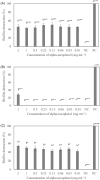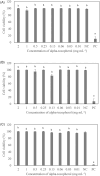Biofilm destruction activity of α-tocopherol against Staphylococcus aureus, Proteus mirabilis, and Pseudomonas aeruginosa
- PMID: 39904546
- PMCID: PMC11992689
- DOI: 10.1093/femsle/fnaf020
Biofilm destruction activity of α-tocopherol against Staphylococcus aureus, Proteus mirabilis, and Pseudomonas aeruginosa
Abstract
Antibiotic resistance and the persistence of sessile cells within biofilms complicate the eradication of biofilm-related infections using conventional antibiotics. This highlights the necessity for alternate therapy methods. The objective of this study was to investigate the biofilm destruction activity of α-tocopherol against Staphylococcus aureus, Proteus mirabilis, and Pseudomonas aeruginosa on polystyrene. α-Tocopherol showed significant biofilm destruction activity on the pre-formed biofilms of S. aureus (45%-46%), Pr. mirabilis (42%-54%), and Ps. aeruginosa (28%). Resazurin assay showed that α-tocopherol disrupted all bacterial biofilms without interfering with their cell viability. Scanning electron microscope images showed lower bacterial cell count and less compacted cell aggregates on polystyrene surfaces after treatment with α-tocopherol. This study demonstrated the biofilm destruction activity of α-tocopherol against S. aureus, Pr. mirabilis, and Ps. aeruginosa. α-Tocopherol could potentially be used to decrease biofilm-associated infections of these bacteria.
Keywords: Gram-negative bacteria; Gram-positive bacteria; anti-biofilm; antimicrobial; biofilm inhibition; vitamin E.
© The Author(s) 2025. Published by Oxford University Press on behalf of FEMS.
Conflict of interest statement
None declared.
Figures



Similar articles
-
Anti-biofilm activity of biogenic selenium nanoparticles and selenium dioxide against clinical isolates of Staphylococcus aureus, Pseudomonas aeruginosa, and Proteus mirabilis.J Trace Elem Med Biol. 2015 Jan;29:235-41. doi: 10.1016/j.jtemb.2014.07.020. Epub 2014 Aug 9. J Trace Elem Med Biol. 2015. PMID: 25175509
-
Pseudomonas aeruginosa Increases the Sensitivity of Biofilm-Grown Staphylococcus aureus to Membrane-Targeting Antiseptics and Antibiotics.mBio. 2019 Jul 30;10(4):e01501-19. doi: 10.1128/mBio.01501-19. mBio. 2019. PMID: 31363032 Free PMC article.
-
Melittin and its potential in the destruction and inhibition of the biofilm formation by Staphylococcus aureus, Escherichia coli and Pseudomonas aeruginosa isolated from bovine milk.Microb Pathog. 2017 Nov;112:57-62. doi: 10.1016/j.micpath.2017.09.046. Epub 2017 Sep 21. Microb Pathog. 2017. PMID: 28943153
-
Malachite green-conjugated multi-walled carbon nanotubes potentiate antimicrobial photodynamic inactivation of planktonic cells and biofilms of Pseudomonas aeruginosa and Staphylococcus aureus.Int J Nanomedicine. 2019 May 27;14:3861-3874. doi: 10.2147/IJN.S202734. eCollection 2019. Int J Nanomedicine. 2019. PMID: 31213806 Free PMC article.
-
Surviving as a Community: Antibiotic Tolerance and Persistence in Bacterial Biofilms.Cell Host Microbe. 2019 Jul 10;26(1):15-21. doi: 10.1016/j.chom.2019.06.002. Cell Host Microbe. 2019. PMID: 31295420 Free PMC article. Review.
References
-
- Andrade JC, Morais-Braga MFB, Guedes GMM et al. Enhancement of the antibiotic activity of aminoglycosides by alpha-tocopherol and other cholesterol derivates. Biomed Pharmacother. 2014;68:1065–9. - PubMed
-
- Andrews JM. Determination of minimum inhibitory concentrations. J Antimicrob Chemother. 2001;48:5–16. - PubMed
-
- Banche G, Allizond V, Bracco P et al. Interplay between surface properties of standard, vitamin E blended and oxidised ultra high molecular weight polyethylene used in total joint replacement and adhesion of Staphylococcus aureus and Escherichia coli. Bone Joint J. 2014;96-B:497–501. - PubMed
-
- Campoccia D, Visai L, Renò F et al. Bacterial adhesion to poly-(d,l)lactic acid blended with vitamin E: toward gentle anti-infective biomaterials. J Biomed Mater Res. 2015;103:1447–58. - PubMed
MeSH terms
Substances
Grants and funding
LinkOut - more resources
Full Text Sources
Medical
Molecular Biology Databases
Research Materials

